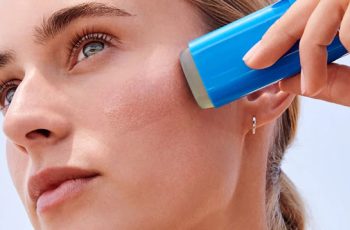Our eyes are a window: They can reveal when we’re not getting enough sleep, whether we had too much alcohol the night before, or how many times we’ve laughed in our lives.
This is because the skin around the eyes is the thinnest on the face and is therefore more susceptible to irritation, dryness and environmental damage, which can lead to signs of aging.
According to a 2015 study published in Advanced, that’s because the skin around the eyes doesn’t have as many oil glands and collagen as the face and other parts of the body, making it more prone to dryness, sagging, fine lines lines and wrinkles. biomedical research.
To prevent these common eye problems, dermatologists emphasize the use of special eye care products as they are specially designed for the delicate eye area.
“When treating skin problems around the eyes, it’s important to start by properly diagnosing the problem for the best treatment and results,” says Joshua Zeichner, MD, director of cosmetic and clinical research in the Department of Dermatology at Mount Sinai Hospital in New York City.
Fortunately, when it comes to eye skin care, there is a wide variety of products to choose from, including serums, creams, oils, and boosters. So if you’ve never used eye care products before, don’t worry—it’s never too late to
start, and these pro tips will guide you to the best solution for your needs.
From lightening dark circles to reducing puffiness, here are expert tips and product recommendations for treating common eye skin concerns.
Reduce fine lines and crow’s feet. Crow’s feet are a sign of a happy life. These horizontal wrinkles that form in the outer corners of the eyes are largely the result of muscle movement during smiling and laughing.
If you’re trying to reduce these symptoms, “retinoid products can be very helpful,” says Ranella Hirsch, MD, a board-certified dermatologist in Cambridge, Massachusetts. Retinoids can stimulate collagen production in the skin,
which can help smooth some wrinkles.
Prescription retinoids such as tretinoin 0.025% cream can be very effective, Dr. Hirsch, however, recommends confining yourself to the area outside the eye socket (you can feel the orbital bone surrounding it).
To treat fine lines under the eyes, you can try an over-the-counter eye cream that contains retinol, a less potent retinoid. Whether you’re using a prescription retinoid or an over-the-counter retinoid, start by massaging a small spot one night a week, then gradually apply over several nights to limit dryness and irritation.
If you can’t tolerate retinoids, consider peptide eye cream, which may also stimulate collagen production. Don’t forget to protect your skin with products with a broad-spectrum SPF of 50 or higher. (To avoid eye irritation, Dr.
Hirsch recommends using a sunscreen that won’t get in your eyes.) Lightens dark circles under the eyes Lack of sleep can make dark circles worse, but it’s usually not the main cause. “The main causes of dark circles are
hyperpigmentation of the skin and the cavities around the eyes that develop with age,” says Dr. illustrator. To determine your strain, stand in front of a mirror in bright light. “Gently pinch a piece of dark skin and pull it forward slightly,” he advises. “If the skin is still very dark, it’s a sign of hyperpigmentation.
Dimples create shadows around the eyes when the skin tone looks normal.” For dark circles caused by hyperpigmentation, Dr. Zeichner is an eye cream with vitamin C, which helps reduce the production of melanin, also known as pigment, in the skin. Choose a formula that comes in a tube or pump bottle rather than a jar to preserve the potency of the ingredients and use it daily.
with it, and for a few months, to see results.” For more severe dark circles, you might want to consider in-office laser treatment, Dr. Advises.
There are deer ahead. Avoid rubbing your eyes, as prolonged rubbing can stimulate the production of more melanin, especially in highly melanized skin types. Tooth decay is another problem that occurs when subcutaneous fat in the tear trough (the area between the lower eyelid and upper cheek) decreases with age, causing the tear trough to appear deeper and darker. “An eye cream enriched with hyaluronic acid can help plump the skin,” explains Dr. illustrator. To further enhance results, consider injectable fillers. Drinking water can also help — while the water you drink won’t directly hydrate your skin, dimpled skin will be less noticeable when you’re well hydrated. reduce swelling Going to bed drunk or shedding a few tears can cause puffy eyes.
However, chronic swelling of the eye is often the result of allergies. If you suffer from seasonal allergies, antihistamines can help curb the swelling process if used properly. “You don’t want to wait until you have symptoms to
start,” says Dr. deer. “Ideally, taking an antihistamine daily for two weeks before a pollen outbreak will keep you one step ahead of your allergies.” Hirsch recommends buying hypoallergenic pillowcases: “This keeps household allergens from sticking to the pillow, eliminating the allergens they can create Significant effect.”
Prolonged exposure while sleeping. ” For an immediate fix, apply an eye cream that contains caffeine, an anti-inflammatory that helps constrict blood vessels and flush excess fluid under the skin. You can also wear popular eye masks to reduce swelling or apply cold compresses to your eyes, as cold temperatures also constrict blood vessels. (Just make sure you keep your head elevated to promote drainage.) “If you’re prone to puffiness, using a retinol eye cream daily will help tighten the skin and make puffiness less noticeable,” says Dr. illustrator. However, if you have a greasy-looking bump under your eye that won’t go away no matter how hard you try, “it could be
because you have sagging cheek pads that can’t be treated with skin care products, but it’s less noticeable.” can be manufactured. “Injectable fillers or permanent fixation through surgery,” says Dr. illustrator.



